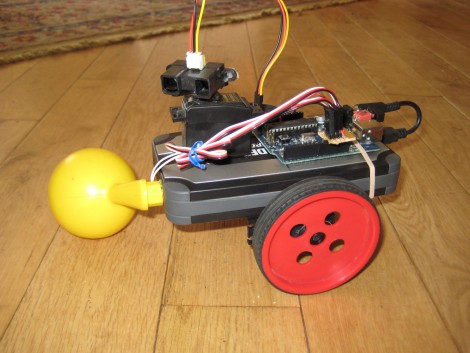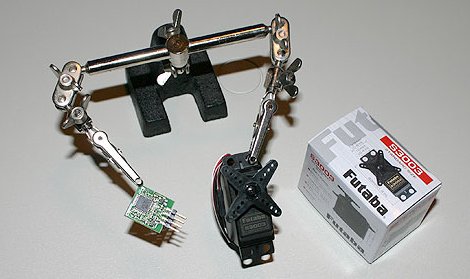[DJ Sures] got his hands on a broken Teddy Ruxpin doll and decided to give it a new robotic life. You may want to ask the children to leave the room before viewing the video after the break. It starts right off with little Teddy having his throat slashed in order to get at the parts in the head. After retrofitting the eyes, mouth, neck, and arms with servos, Teddy gets a Bluetooth upgrade that lets you control his movements wirelessly. [DJ Sures] even has plans to get the little guy up and walking, far exceeding the original capabilities.
servo463 Articles
The Wandering Arduinobot

You almost have to love this Arduino based robot just because of the wheels and third leg support. Look closely, do you recognize them? Yep, they’re Capsela parts! That’s a blast from the past and we wonder why we don’t see the strange building toys of yore used in more hacks?
But we digress, this little bugger guy uses continuous rotation servos for locomotion. Perched atop the body is a third servo which scans an IR range finder back and forth to look out for obstacles in its path. The body itself is a Black and Decker rechargeable battery pack called Pocket Power which includes a USB port for a regulated 5V supply. One thing’s for sure, this little guy is fantastic at avoiding pizza and beer… you’ll just have to see for yourself after the break.
USB Controller For Multiple Servos

[dunk] constructed an easy to use AVR-based USB controller with the ability to drive up to six R/C hobby servos at once. While the USB-powered Atmega8 he used supplies the necessary PWM signaling for all of the servos, an external power supply rated up to 30v at 3A is necessary to provide the 5v of power each servo requires. His project is an extension of the USB servo controller built by [Ronald Schaten] and includes several significant upgrades. The addition of 5 more servos aside, [dunk] switched to AVRlib routines for multi-servo control and PWM management, as well as added the aforementioned power supply to prevent an excessive current draw on the USB port. His tutorial includes a complete parts list, Eagle PCB schematic, the required USB servo source code, as well as a sampling of commands that can be issued to the servo controller.
The OpenServo Project

When it comes to using servos in projects, there is a definite distinction between the cheap ones and the expensive high power and precision models. The OpenServo project gives you a couple options for enhancing your servo experience. By replacing the control board with a new one based on a familiar microcontroller, a whole new set of features can be attained. For those of you out there with a need for servos like these, you can buy the pre-built replacement board (unfortunately sold out right now), or build your own from the provided schematic, BOM, and source code.
Building A Creepy Doll Army

Want your very own Chucky doll to scare the crap out of the roommates? [Gzip] shows you how to make this happen by adding servo-based animatronics to old dolls. In the video after the break you can see the doll throw up her arms and turn her head thanks to a motor in each shoulder and one in her melon. You won’t see it in the clip, but the legs are motorized too meaning that some creative coding might have this old gal awkwardly crawling across the room (with knife in hand). Then again, maybe this is just the inspiration you need to get off your bum and finish the Santa-Pede Challenge. Submissions are due a week from today!
Zipitbot

[Nulluser’s] Zipit was fine, but it couldn’t go anywhere on its own. Adding some motors and a microcontroller fixed that issue, and now he’s got a little robot called the Zipitbot. That’s a dsPIC board on top which communicates with the Zipit over an I2C bus. Four servo motors provide plenty of power to the wheels,with some extra battery packs nestled between them.
Since the Zipit is running Linux, and already has WiFi hardware, it’s not too hard to add Internet control. With this in mind there’s a webcam on the front to broadcast a video feed for use when controlling it remotely. See a couple of videos of this hack after the break.
Improving A Hexapod Design
[JC] built himself a hexapod based on a project he found on the Internet. It worked fairly well, but was mechanically weak and prone to breakage. He set out to improve the design and came up with the unit seen above. It uses three servo motors to control the six legs, and walks quite well as seen in the quick clip after the break. It’s not quite as agile as the little acrobatic six-legger we saw yesterday, but the movement is quite pleasing and it’s capable of moving forward, backward, and turning. [JC’s] post is four pages in all so don’t forget to seek out his links for the construction, linkage, and servo control pages to find concept drawings, cad designs, and his thoughts on the process.












